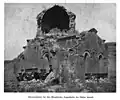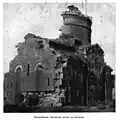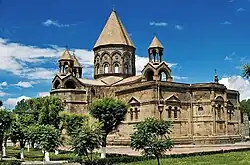| Horomos Monastery | |
|---|---|
_(4217959655).jpg.webp) Actual state of the monastery | |
| Religion | |
| Affiliation | Armenian Apostolic Church |
| Status | ruined |
| Location | |
| Location | near Ani |
 Shown within Turkey | |
| Geographic coordinates | 40°31′11″N 43°37′45″E / 40.519689°N 43.629158°E |
| Architecture | |
| Architect(s) | Hovhannes |
| Style | Armenian |
| Completed | 10th-13th century |
Horomos (Armenian: Հոռոմոս), also known as Horomosivank or Ghoshavank, is an abandoned and ruined medieval Armenian monastic complex about 15 kilometers northeast of the ruins of Ani (the capital of Bagratid Armenia) in present-day eastern Turkey. With its collection of churches, chapels and tombs, Horomos has been described as one of the most significant spiritual and cultural religious centers in medieval Armenia and one of the largest in all the Christian East.[1]
History
Horomos was founded by a group of Armenian monks around 931-36, during the reign of King Abas I Bagratuni (r. ca. 929-953).[2] The monastic complex was enlarged over time and came to include the individual churches of Sts. John, Minas, and George, a series of large halls (gavits), a triumphal arch, and various smaller chapels and mausolea. The monastery continued to function after the fall of Ani, but appears to have been temporary abandoned in the early 17th century and then reoccupied and repaired in 1685. It continued to operate as a monastery until it was finally abandoned due to the Armenian Genocide.[3]
Some time after 1965, the Monastery of Horomos was partly destroyed, most likely as part of the Turkish government's policy of cultural genocide. A tomb believed to belong to King Ashot III (953-977) which had survived at least up to 1920 is now nowhere to be found.[4] Some buildings have entirely vanished, and most of the surviving walls have been stripped of their facing masonry. The dome of the Church of the St. John collapsed in the 1970s. The site lies next to the Armenian border and gaining permission to visit the monastery is all but impossible (2003).[5]
Old photos
 East side of the church of St. John at Horomos; early 20th century photograph
East side of the church of St. John at Horomos; early 20th century photograph









Actual state
References
- ↑ Edda Vartanyan (ed.), "Horomos Monastery, Art and History", 2015. Pages 17 and 55.
- ↑ (in French) Thierry, Jean Michel (1980). Le couvent armenien d'Horomos. Leuven: Peeters, p. 1.
- ↑ Edda Vartanyan (ed.), "Horomos Monastery, Art and History", 2015. Pages 49 and 52.
- ↑ Manuk-Khaloyan, Armen, "In the Cemetery of their Ancestors: The Royal Burial Tombs of the Bagratuni Kings of Greater Armenia (890-1073/79)", Revue des Études Arméniennes 35 (2013), pp. 164-66.
- ↑ "Destruction of Horomos Monastery". Asbarez. 27 August 2003. Retrieved June 1, 2009.
Further reading
- Kazaryan, Armen. The Zhamatun of Horomos: The Shaping of an Unprecedented Type of Fore-church Hall, in: kunsttexte.de, Nr. 3, 2014
- (in French) Baladian, Ani and Jean Michel Thierry (eds.) with a contribution by J. P. Mahé (2002), Le couvent de Horomos d'après les archives de Toros Toramanian. Paris: Académie des inscriptions et belles-lettres.
- Manuk-Khaloyan, Armen (2013), "In the Cemetery of their Ancestors: The Royal Burial Tombs of the Bagratuni Kings of Greater Armenia (890-1073/79)", Revue des Études Arméniennes 35, pp. 131–202.
- Sinclair, Thomas A. (1987). Eastern Turkey: An Architectural and Archaeological Survey. London: Pindar Press, vol. 1.
- (in French) Thierry, Jean Michel (1980). Le couvent armenien d'Horomos. Leuven: Peeters.
External links
- The Monastery of Horomos at VirtualAni.org
- About Horomos Monastery




_(4221860776).jpg.webp)
_(4221864406).jpg.webp)
_(4218808492).jpg.webp)





_(4218751594).jpg.webp)




_(4218753352).jpg.webp)



